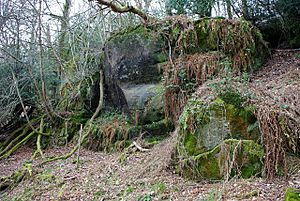Wakehurst and Chiddingly Woods facts for kids
| Site of Special Scientific Interest | |

Sandstone crag in Tilgate Wood
|
|
| Area of Search | West Sussex |
|---|---|
| Interest | Biological Geological |
| Area | 155.9 hectares (385 acres) |
| Notification | 1987 |
| Location map | Magic Map |
Wakehurst and Chiddingly Woods is a special natural area in West Sussex, England. It covers about 155.9 hectares (385 acres) and is located south-east of Crawley. This site is important for both its plants and animals, and its unique geology. It's officially called a Site of Special Scientific Interest (SSSI).
This area is also recognized as a top-grade Nature Conservation Review site. Part of it is even a Geological Conservation Review site, meaning its rocks and landforms are very important for science.
Contents
What Makes Wakehurst and Chiddingly Woods Special?
These woods have steep valleys. These valleys were formed by streams cutting through different types of rock. The rocks include Wadhurst Clay and Tunbridge Wells sands. This process has exposed cool sandstone outcrops.
A Unique Micro-Climate
The valleys here have a special warm and moist environment. This is called a micro-climate. Because of this, you can find a rich variety of plants. These include many types of ferns, mosses, liverworts, and lichens.
Home to Many Birds
The woods are also a great place for birds. Many different kinds of birds live and breed here. This makes it an important spot for birdwatchers and nature lovers.
The Importance of Chiddingly Wood's Geology
Chiddingly Wood is especially important for its geology. Over time, the sandstone here has been shaped by the weather. This has created interesting sculptured rock blocks. You can also see many tiny weathering features on the rocks. These features help scientists understand how rocks change over time.

